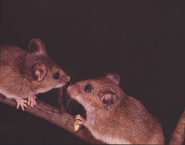26. Hantavirus Identification - Nifty 50

Researchers, funded by NSF, helped make possible the rapid discovery of the cause of an outbreak of a deadly new virus that caused death in nearly half of the people who contracted it.
NSF-funded research helped track the killer virus to the deer mouse, a common rodent that occurs throughout much of North America. The outbreak was centered in the American southwest, but human cases have now been confirmed in 30 states and three Canadian provinces. The new hantavirus is apparently transferred directly from rodents to humans by inhaling of contaminated dust particles.
Verifying the virus
Biologists working in the NSF-supported research collections of the University of New Mexico's Museum of Southwestern Biology were able to verify the identity of the rodent reservoir of the virus. They were also able to confirm the existence of the deadly virus in tissues archived in the museum's collections prior to the 1993 outbreak.
In addition, biologists at the NSF-funded Sevilleta Long-term Ecological Research (LTER) site in New Mexico were able to show rodent populations increased in the region dramatically in 1993 following a series of wetter and milder winters associated with the El Niño Southern Oscillation.
Sevilleta researchers were also able to demonstrate an association with this weather pattern and increased cases of human plague. Other NSF-supported researchers have found similar biologically complex interactions among rodent populations, moths and climate to explain the cycling of Lyme Disease in New York.
Original publication date: April 2000


